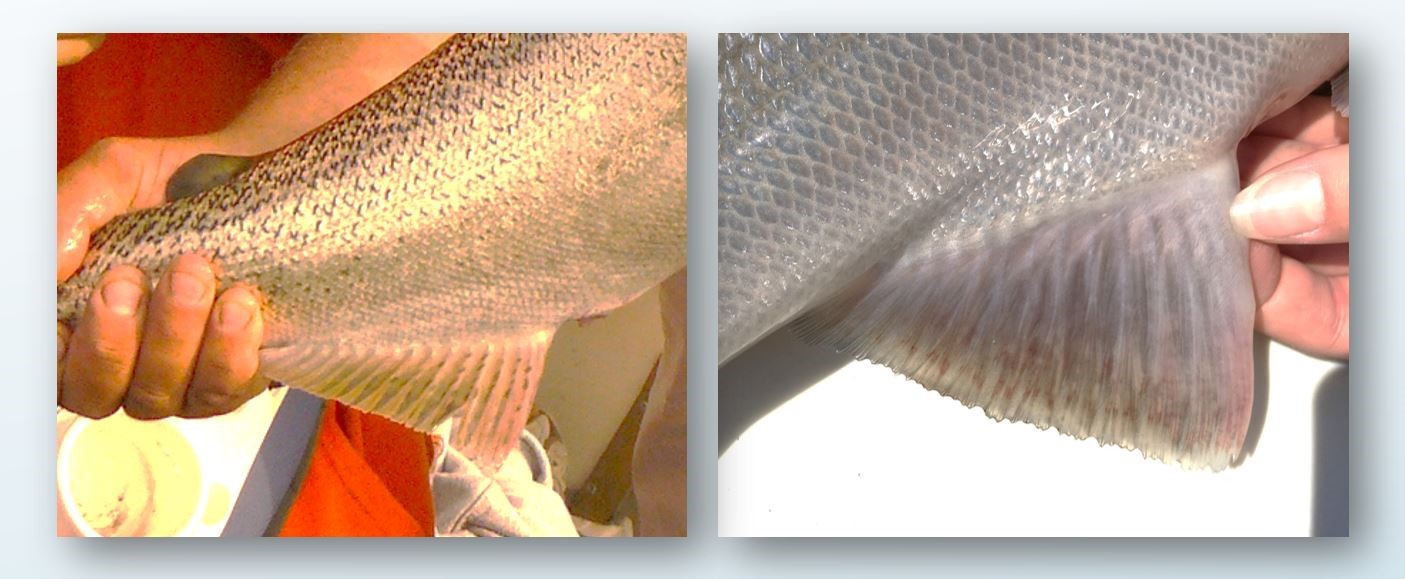What’s the catch? New video from Michigan Sea Grant helps anglers identify Great Lakes fish
Seasoned pros and newbies alike will learn new tips and tricks for identifying big lake salmon and trout.

Catching Great Lakes fish can be quite a challenge, and the challenge doesn’t end when the fish is in the net. Some species of salmon and trout can be very difficult to distinguish from one another. This is particularly true for adult fish before they develop spawning coloration. The new YouTube video from Michigan Sea Grant expands on this one-page ID factsheet to show anglers several examples of individual fish with a variety of characteristics to make identification easier.
In most Great Lakes waters the only species with light markings on a dark background is the native lake trout, which is a member of the char genus (Salvelinus). In coastal areas of Lake Superior, the native coaster brook trout (another native char) also has light markings on a dark background but does not have the deeply forked tail of a lake trout.
Beyond this, things get more complicated. When fishing on the Great Lakes, anglers can catch six additional non-native salmon and trout species with silvery coloration and dark markings. These include four Pacific salmon (genus Oncorhynchus) and two Atlantic species in the genus Salmo.
Chinook salmon and coho salmon are among the most popular gamefish in the Great Lakes, but they can be surprisingly difficult to tell apart. Many existing identification guides rely on the coloration of the gums and mouth, along with spotting patterns on the tail, to distinguish between Chinook and coho salmon. However, spotting patterns on coho salmon tails can be very similar to Chinook salmon, and it is important to look specifically at the base of the teeth in the lower jaw when relying on gum coloration.
The shape of the anal fin is a very useful characteristic that is often ignored. Chinook salmon have a long, low anal fin with a fin ray that extends less than two-thirds the length of the fin base while the coho salmon has a longer fin ray. Sound complicated? It is awkward to describe, but after seeing a few examples from the video it is easy to learn what to look for.

Atlantic salmon and brown trout (both members of the Salmo genus) are even more of a challenge. Being closely related and highly variable in terms of coloration and spotting, these species are probably misidentified more often than any other Great Lakes fish. The length of the upper jaw (which typically extends beyond the eye only for brown trout), tail shape (more forked for Atlantic salmon) and the ability to tail your fish (much easier for an Atlantic salmon) provide some easy clues to the identity of your fish. Unfortunately, these are not definitive, either, particularly with spawning phase males.
Your best bet is to look inside the fish’s mouth. An Atlantic salmon will have a single row of small vomerine teeth running down the middle of the roof of the mouth, while brown trout have two rows of well-developed vomerine teeth in a zigzag pattern. Again, it may sound complicated but a quick look at the video or this comprehensive brochure will help.
Part of the fun in Great Lakes fishing is that you never know what you might hook into. With these new resources, it is easier than ever to find out what’s the catch.
Michigan Sea Grant helps to foster economic growth and protect Michigan’s coastal, Great Lakes resources through education, research, and outreach. A collaborative effort of the University of Michigan and Michigan State University and its MSU Extension, Michigan Sea Grant is part of the NOAA-National Sea Grant network of 34 university-based programs.
This report was prepared by Michigan Sea Grant under award NA180AR4170102 from the National Oceanic and Atmospheric Administration, U.S. Department of Commerce through the Regents of the University of Michigan. The statements, findings, conclusions, and recommendations are those of the author(s) and do not necessarily reflect the views of the National Oceanic and Atmospheric Administration, the Department of Commerce, or the Regents of the University of Michigan.



 Print
Print Email
Email

